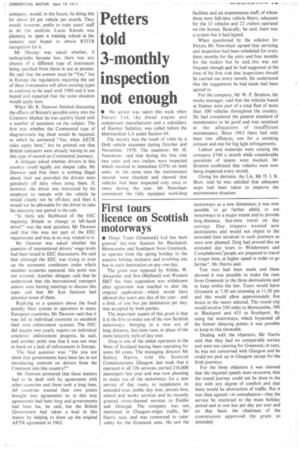First tours licence on Scottish motorways
Page 21

If you've noticed an error in this article please click here to report it so we can fix it.
• Doigs Tours (Greenock) Ltd has been granted day tour licences for Blackpool, Morecambe and Southport from Greenock, to operate from the spring holiday to the autumn holiday inclusive and involving one bus to each destination on any one day.
The grant was opposed by Ribble, W. Alexander and Son (Midland) and Western SMT hut their opposition was withdrawn after agreement was reached to alter the original application—which would have allowed day tours any day of the year—and a limit, of one bus per destination per day, was accepted by both parties.
The important aspect of this grant is that it is the first to make use of the new Scottish motorways, bringing in a new era of long-distance, fast-time runs, in place of the more leisurely style of day tour.
Doig is one of the oldest operators in the West of Scotland having been operating for some 80 years. The managing director Mr Sidney Harris, told the Scottish Commissioners, Glasgow, last week that it operated in all 126 services, carried 216,000 passengers last year and was now planning to make use of the motorways for a new service of day tours, to supplement its extended tour, public day tour, private hire, school and works services and its recently granted cross-channel services to Dublin and Donegal. The company was not/ interested in Glasgow-origin traffic, Mr Harris said, and was concerned to cater solely for the Greenock area. He saw the
motorways as a new dimension; it was now possible to go farther afield, to use motorways to a major extent and to provide long-distance, fast-time travel on day outings. Day trippers wanted new destinations and would not object to the extended time involved in such journeys as were now planned. Doig had proved this on extended day tours to Windermere and Campbeltown;"people are prepared to travel a longer time, at higher speed in order to go farther", Mr Harris said.
Test runs had been made and these showed it was possible to make the runs from Greenock to the three destinations and to keep within the law. Tours would leave Greenock at 7.30 am returning at 1 L30 pm and this would allow approximately five hours in the resort selected. The round trip would involve 350 miles to Morecambe, 390 to Blackpool and 435 to Southport. By using the motorways, which bypassed all the former delaying points, it was possible to keep to this timetable.
Dealing with the objectors, Mr Harris said that they had no comparable service and were not catering for Greenock; in turn, he was not concerned with Glasgow and he could not pick up in Glasgow except for the Irish journeys.
For the three objectors it was claimed that the required speeds were excessive, that the round journey could not be done in the day with any degree of comfort and that there would be abstraction of traffic. But it was then agreed—in consultation—that the service be restricted to the main holiday period and to one bus per day per tour and on that basis the chairman of the commission approved the grant as amended.




























































































